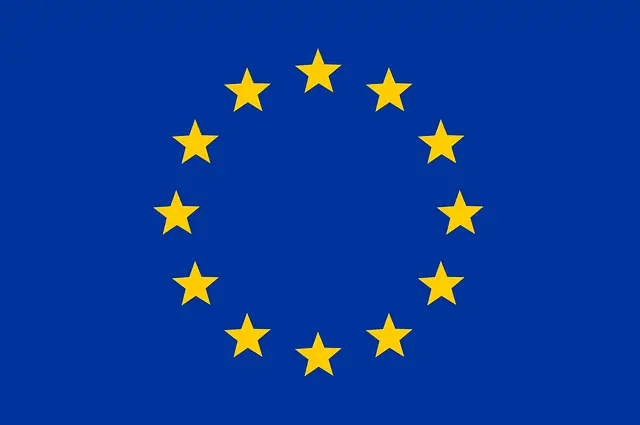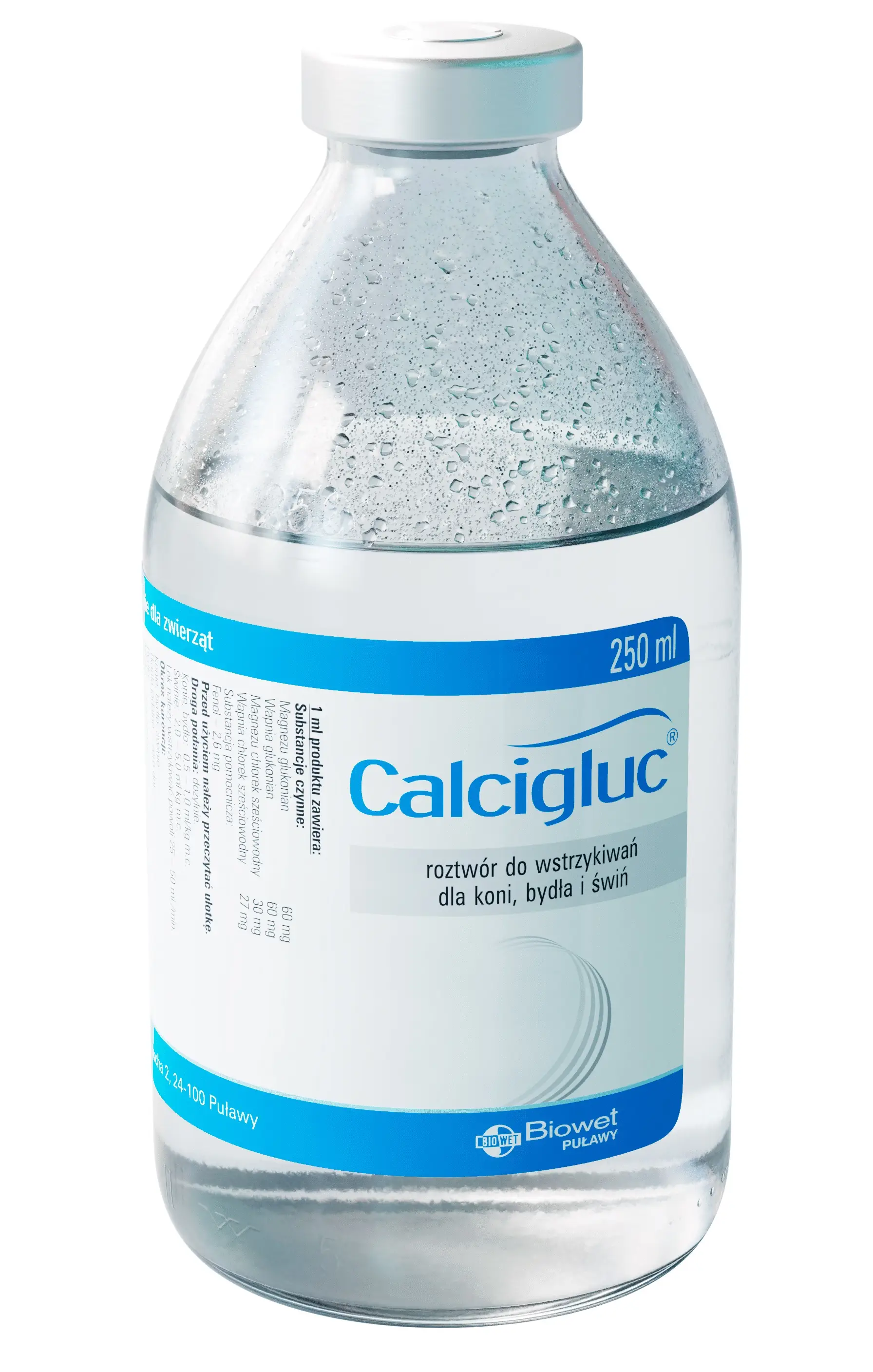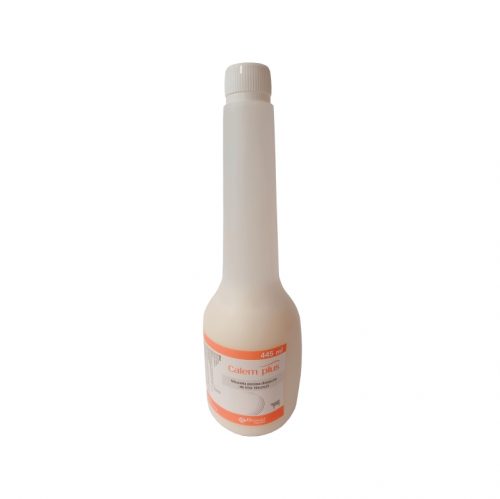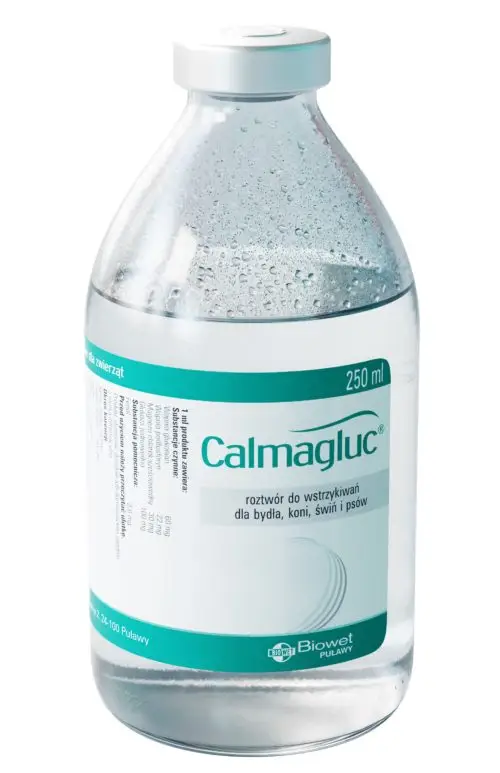Description
Calcigluc (60 mg + 60mg + 30mg + 27mg)/ml solution for injection for horses, cattle and pigs
Statement of the active substance(s) and other ingredient(s)
Each ml contains:
Active substances:
Magnesium gluconate 60 mg
Calcium gluconate 60 mg
Magnesium chloride hexahydrate 30 mg
Calcium chloride hexahydrate 27 mg
Excipient:
Phenol 2.6 mg
Clear, colourless or slightly yellow solution.
Target species
Horses, cattle, pigs.
Indications for use
Horses: laminitis, urticaria.
Cattle: parturient paresis in cows, disorders of calcium and magnesium metabolism, such as Downer cow syndrome, hypocalcaemia and subclinical hypomagnesemia, acute tetany caused by hypomagnesaemia.
Pigs: postparturient hypocalcaemia in sows, rickets.
Contraindications
Do not use in hyperparathyroidism and end-stage renal failure.
Do not use in hypermagnesemia with heart conduction disorders.
Do not use in case of earlier treatment with cardiac glycosides.
Special warnings
Special warnings:
Intravenous injection of high product doses, especially in animals in poor health condition, may lead to hypercalcemia.
Special precautions for safe use in the target species:
To avoid administration of an excessively high dose, determine body weight as accurately as possible. In order to recognise symptoms of overdose in good time, monitor heart functions during the injection.
Inject the product slowly at 25-50 ml/minute, warm the product to body temperature before administration.
Special precautions to be taken by the person administering the veterinary medicinal product to animals:
Do not eat, drink and smoke when handling the product.
Take special caution to avoid self-injection.
In case of accidental self-injection, seek medical advice immediately and show the package leaflet or the label to the physician.
Wash hands after use.
Pregnancy and lactation:
Can be used during pregnancy and lactation.
Interaction with other medicinal products and other forms of interaction:
Cardiac glycosides enhance cardiotoxic action of calcium ions. Beta-adrenergic agonists and methylxanthines enhance the effect of calcium ions on the heart. Simultaneous oral administration of tetracyclines increases binding of calcium ions with proteins. Calcium salts administered orally reduce intake of tetracyclines and fluoride compounds (a 3-hour interval is required between administration of these drugs and calcium compounds). Vitamin D, parathormone and acidic pH of feed increase calcium intake, whereas calcitonin, glucocorticoids, excessive amount of lipids, alkaline feed, phytate (e.g. in cereal products), oxalates (e.g. in spinach, rhubarb) and phosphates (milk and milk products) reduce calcium intake.
High calcium doses administered simultaneously with cardiac glycosides (strophanthin and digoxin derivatives) enhance their action and may lead to arrhythmia.
Thiazide diuretics boost calcium re-absorption and pose the risk of hypercalcemia.
High calcium doses administered simultaneously with vitamin D may attenuate the effect of verapamil and other calcium channel blockers.
Overdose:
Overdosing the product leads to hypercalcemia and hypermagnesemia, and to increased urinary excretion of calcium and magnesium. Symptoms of hypercalcemia and/or hypermagnesemia may include: nausea, vomiting, polydipsia, polyuria, dehydration and constipation. Long-term overdose leading to hypercalcemia and/or hypermagnesemia may cause vascular and internal organ calcification. Calcium supply of more than 2000 mg/24 hours, over a period of several months constitutes a threshold and may be the cause of poisonings. Arrhythmia is a symptom of overdose. When it occurs, discontinue administration of the product.
In case of overdose, discontinue treatment immediately and replenish fluid deficiency. In case of long-term overdose, use oral and intravenous rehydration with NaCl solutions. Simultaneously (or after rehydration) administer loop diuretics (e.g. Furosemide) in order to increase calcium excretion and prevent the increase in the fluid volume.
Do not administer thiazide diuretics.
Major incompatibilities:
In the absence of compatibility studies, this veterinary medicinal product must not be mixed with other veterinary medicinal products.
Adverse events
Target species: horses, cattle, pigs.
| Very rare (< 1 animal/10 000 animals treated, including isolated reports) | Hypercalcemia1 |
1 May occur during intravenous injections, especially in animals in poor health condition. In case of hypercalcemia, bradycardia is observed, the power of muscle contraction and contraction rate increase, followed by tachycardia and extra contractions. This results in acute myocardial hypoxia, followed by muscle tremor, anxiety, sweats, lowered blood pressure leading to collapse.
Reporting adverse events is important. It allows continuous safety monitoring of a veterinary medicinal product. If you notice any side effects, even those not already listed in this package leaflet, or you think that the medicine has not worked, please contact, in the first instance, your veterinarian. You can also report any adverse events to the marketing authorization holder using the contact details found at the end of this leaflet, or via your national reporting system: Department for Documentation Assessment and Pharmacovigilance of Veterinary Medicinal Products, Office for Registration of Medicinal Products, Medical Devices and Biocidal Products, Al. Jerozolimskie 181C, PL-02-222 Warsaw, Tel.: +48 22 49-21-687, Fax: +48 22 49-21-605, https://smz.ezdrowie.gov.pl.
Dosage for each target species, routes and method of administration
Route of administration: intravenous.
Horses, cattle: 0.5 – 1.0 ml/kg b.w.
Pigs: 2.0 – 5.0 ml/kg b.w.
Advice on correct administration
Inject the veterinary medicinal product slowly at 25 – 50 ml/min.
Withdrawal period(s)
Horses, cattle, pigs:
Meat and offal – zero days.
Cattle:
Milk – zero hours.
Special storage precautions
Keep out of the sight and reach of children.
Store below 25℃. Protect from light. Do not freeze.
Do not use this veterinary medicinal product after the expiry date which is stated on the label after EXP. The expiry date refers to the last day of that month.
Shelf life after first opening the immediate packaging: 28 days
Special precautions for disposal
Medicines should not be disposed of via wastewater or household waste.
Use take-back schemes for the disposal of any unused veterinary medicinal product or waste materials derived thereof in accordance with local requirements and with any applicable national collection systems. These measures should help to protect the environment.
Ask your veterinary surgeon how to dispose of medicines no longer required.
Classification of veterinary medicinal products
Veterinary medicinal product subject to prescription.
Marketing authorisation numbers and pack sizes
Marketing authorisation: 790/99
Pack size: 250 ml
Date on which the package leaflet was last revised
26/09/2024
Detailed information on this veterinary medicinal product is available in the Union Product Database (https://medicines.health.europa.eu/veterinary).
Contact details
Marketing authorisation holder and manufacturer responsible for batch release:
Biowet Puławy Sp. z o.o.
Henryka Arciucha 2
24-100 Puławy
Poland
Tel./Fax: + 48 (81) 886 33 53, Tel.: + 48 (81) 888 91 00
e-mail: sekretariat@biowet.pl
Contact details to report suspected adverse events:
Biowet Puławy Sp. z o.o.
Henryka Arciucha 2
24-100 Puławy
Poland
Tel: + 48 (81) 888 91 33, + 48 509 750 444
e-mail: biowet@biowet.pl
SPC 2024-09-26
2025-03-21






